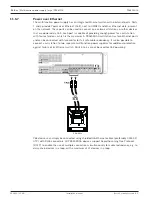
PRAESENSA
Multifunction power supply, large | PRA-MPS3 | en
111
Bosch Security Systems B.V.
Installation manual
2019.11 | V1.00 |
the battery hasn't reached full yet. The charger measures the battery voltage and, in
combination with the actual temperature, decides on the state of charge of the battery.
At a certain voltage, corresponding to a state of charge of the battery of 70‑80%, the
charger will enter the absorption stage. The battery status LED blinks green while in
stage
1.
–
Stage 2 (absorption charge)
: In this stage the charger maintains a steady voltage, while
the charging current declines. The lower current going into the battery safely brings up
the charge on the battery without overheating it. This stage takes more time as the
charging current is lower. The current continuously declines until the battery almost
reaches full capacity. Then the charger will enter the float stage. The battery status LED
still blinks green while in stage
2.
–
Stage 3 (float charge)
: The float stage charges the battery to full and maintains the 100%
state of charge. The voltage will decrease and stays at a steady voltage of around 13.5
V
(the exact value adapts to the temperature), which is the maximum voltage a 12
V VRLA
battery can hold. The current will also decrease to the point of trickle charging. It's
essentially the float stage where there is charge going into the battery at all times, but
only at a safe rate to ensure a full state of charge and nothing more. The charger does not
turn off at this point. It is important that the battery is at 100% state of charge to utilize
its full capacity when the PRAESENSA system needs to operate on backup battery, but
this state of charge is also the healthiest regarding battery lifetime. In this stage
3, the
battery status LED is steady green.
Battery lifetime is maximized by using a single 12
V battery, that has all six battery cells at the
same temperature and all cells using the same electrolyte. All cell voltages will be substantially
equal and the switch‑over to the next charging state is well‑defined. Series connected
batteries without battery balancing circuits will not stabilize to the exactly same voltage, while
the switch‑over to the next charging state is determined by the summed voltages of the
distinctive batteries. This causes non-optimum charging and consequently overcharging of one
or more of the series connected batteries, which is the main cause of premature battery aging.
Battery fault reporting
The battery is monitored continuously to prevent damage to the battery and to make sure that
it is available in good state as a backup power source to the system in case of mains power
failures. When a backup power source is not needed, it is allowed to not connect a battery to
the multifunction power supply. In that case make sure that supervision of the battery is
disabled in the configuration of the device to avoid that a battery missing fault is reported by
the system.
When a battery is in fact connected, but the battery supervision is disabled in the
configuration, then the battery will still be charged and used when mains power fails. In order
to prevent damage to the battery, also battery supervision still continues in the background
and even most battery faults will be reported as usual (voltage too high, voltage too low,
battery short circuit, temperature too high, leakage current too high, temperature sensor
missing). Only the results of the battery impedance measurements are suppressed. This mode
could be useful for special situations (not compliant to EN
54‑16 and EN
54‑4), where a
relatively small backup battery is used, to avoid that a fault is reported that the battery
impedance is too high. Make sure that this battery can handle a charging current of 8.5
A and
the maximum current draw of the load, see section
Accurate battery size calculation, page 41
.
Summary of Contents for PRAESENSA
Page 1: ...PRAESENSA Public Address and Voice Alarm System en Installation manual ...
Page 2: ......
Page 193: ......
















































